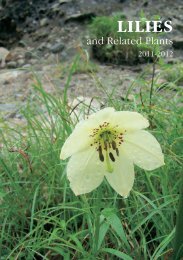LILIES - RHS Lily Group
LILIES - RHS Lily Group
LILIES - RHS Lily Group
You also want an ePaper? Increase the reach of your titles
YUMPU automatically turns print PDFs into web optimized ePapers that Google loves.
Greece . . . . . . . . . . S.C. Atchley of the British Legation in Athens, future author of<br />
‘Wild Flowers of Attica’.<br />
India . . . . . . . . . . . . E.P. Long, Superintendent of the Government Gardens at<br />
Simla and Delhi and C.C. Calder, Director of the Botanical Survey<br />
of India.<br />
And, in a category that would best be described as peripatetic, the famous plant<br />
collectors George Forrest and Frank Kingdon Ward.<br />
The first regular meeting of the <strong>Lily</strong> Committee was held on 11 January 1932. The<br />
two most important subjects of discussion were the <strong>Lily</strong> Conference, scheduled<br />
for 1933, and the contents of the first <strong>Lily</strong> Year Book. Among the proposed<br />
contents were articles on the garden cultivation of each of the three relevant<br />
genera, on commercial lily growing and on a lily disease; a bibliography of the<br />
three genera (which dwindled, in the event, to a list of books in the Lindley<br />
Library – the comprehensiveness of which can be gathered from the fact that it<br />
omitted Redouté’s Liliacées); and a particularly ambitious project, ‘A list of species<br />
of Lilium, Nomocharis and Fritillaria having against each species (i) a reference<br />
to a description, (ii) a reference to an authentic plate, if one exists, (iii) the habitat,<br />
it being indicated throughout whether the plates are coloured or not and whether<br />
the works concerned are in the Lindley Library’. This one also dwindled as what<br />
appeared in the <strong>Lily</strong> Year Book was a list of illustrations of lily species. The Year<br />
Book was eventually published on October 1932 and by 22 nd November it had sold<br />
531 copies – and nearly double that by the following March.<br />
Two sub-Committees were set up to prepare for the Conference; one for<br />
exhibition and one to commission the papers to be presented. The most important<br />
of these were Krelage’s historical article on the early distribution of lilies in<br />
Europe and Daniel Hall’s article ‘A Survey of <strong>Lily</strong> Soils’ (written in collaboration<br />
with M.A.H. Tinker). The <strong>Lily</strong> Conference was held on 11 to 13 July 1933. Ellen<br />
Willmott reviewed it for the Gardeners’ Chronicle, quoting the Abbé Souillet:<br />
“He cannot understand how England could ever have been called perfide Albion,<br />
as he found it the reverse. He was amazed by the magnificent display of lilies in<br />
the hall…Were it not that the <strong>Lily</strong> Week had made such an indelible impression<br />
he would have thought it the ‘dream of a Terrestrial Paradise’.”<br />
The schedule for the competitive classes for the 1932 Conference show is of<br />
interest, particularly in contrast to the present status of lilies at <strong>RHS</strong> shows. In<br />
fact the competitive element has all but disappeared from exhibits of lilies in the<br />
United Kingdom although it has become dominant in the shows of our friends<br />
in the lily world overseas, particularly in North America, Australia, New Zealand<br />
and Europe.<br />
30




